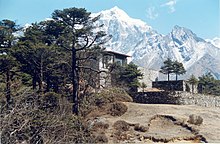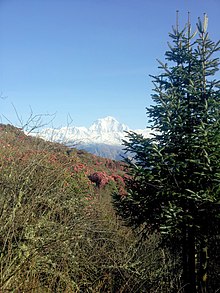Himalayan fir
| Himalayan fir | ||||||||||||
|---|---|---|---|---|---|---|---|---|---|---|---|---|

Himalayan fir ( Abies spectabilis ) |
||||||||||||
| Systematics | ||||||||||||
|
||||||||||||
| Scientific name | ||||||||||||
| Abies spectabilis | ||||||||||||
| ( D. Don ) Spach |

The Himalayan fir ( Abies spectabilis ) is a conifer of the genus of firs in the pine family . Its distribution area is the Himalayas from Afghanistan via Kashmir , northwest India and Nepal to Bhutan.

description
The Himalayan fir is a tree up to 50 meters high with a chest height diameter of up to 1.5 meters. It has a broad, conical crown, widely protruding branches and a rough, scaly bark . The yellowish-gray, brown or reddish-brown branches are thick, furrowed and hairy in the furrows. The buds are rounded and very resinous. The needles are in two to four rows. They are directed forwards and sideways and parted more or less in a V-shape. They are 2.5 to 6 inches long and 2.5 to 3.5 millimeters wide. The needles are leathery, stiff, rounded and have two points. The top is glossy dark green, the underside shows two broad, white stomata bands . The cones are cylindrical and 14 to 18 inches long and 5 to 6 inches wide. They are initially blue-violet-reddish and when ripe they are brown. The scales are 1.5 to 2 centimeters wide, the cover scales are hidden. The seeds are about 1 centimeter long and have broad, wedge-shaped wings.
Distribution and ecology
The natural range of the Himalayan fir is the Himalayas , you can find them there from Afghanistan via Kashmir , northwest India and Nepal, eastern Tibet to Bhutan. There it grows in mountain forests on fresh to moist, acidic to neutral, sandy-humus to sandy-gravelly or rocky, shallow soils in shady to shady locations. It is moderately frost hardy . They are found at altitudes of 2600 to 3800 meters together with various rhododendron species and with the Himalayan birch ( Betula utilis ). Since the mid-90s of the last century, the stocks in Eastern Tibet have been increasingly stressed by the timber industry. There is no reforestation, which means that slope erosion and the discharge of local mudslides (smaller debris flows) occur more frequently in the rainy season of the monsoon. The still closed forests of Himalayan fir trees on the slopes of the mountains in Eastern Tibet form valuable and species-rich habitats with their sub-structure of rhododendron bushes and other woody plants and ground cover and at the same time naturally stabilize the mostly rugged slopes. It is therefore essential to take suitable measures to protect and maintain these sensitive natural areas.
In the Red List of the IUCN Himalayan fir will be deemed not at risk ( "Lower Risk / least concern"). It is pointed out, however, that a new check of the risk is necessary.
Systematics and research history
The Himalayan fir ( Abies spectabilis ) is a species from the genus of firs ( Abies ) from the pine family (Pinaceae). It is assigned to the section Pseudopicea . It was first described by David Don in 1824 under the Basionym Pinus spectabilis before it was assigned to the genus Abies by Édouard Spach in 1841 . Other synonyms are Abies webbiana (Wall. Ex D.Don) Lindl. and Pinus webbiana Wall. ex D.Don
use
The Himalayan fir is very rarely used because of its wood.
Since the mid-1990s, the Himalayan fir stocks in eastern Tibet have been increasingly used by the timber industry. So far there has been no reforestation of the stocks.
proof
literature
- Andreas Roloff , Andreas Bärtels: Flora of the woods. Purpose, properties and use. With a winter key from Bernd Schulz. 3rd, corrected edition. Eugen Ulmer, Stuttgart (Hohenheim) 2008, ISBN 978-3-8001-5614-6 , p. 714.
Individual evidence
- ↑ a b c Roloff et al .: Flora of the Woods , p. 714
- ^ A b Liguo Fu, Nan Li, Thomas S. Elias, Robert R. Mill: Abies spectabilis . In: Wu Zheng-yi, Peter H. Raven (Ed.): Flora of China . Volume 4: Cycadaceae through Fagaceae . Science Press / Missouri Botanical Garden Press, Beijing / St. Louis 1999, ISBN 0-915279-70-3 , pp. 51 (English).
- ↑ Christopher J. Earle: Abies spectabilis. In: The Gymnosperm Database. Retrieved January 9, 2011 .
- ↑ Abies spectabilis in the endangered Red List species the IUCN 2010. Posted by: Conifer Specialist Group, 1998. Accessed January 9, 2011th
- ↑ a b Abies spectabilis. In: Germplasm Resources Information Network (GRIN). United States Department of Agriculture, accessed January 9, 2011 .
- ↑ Pinus spectabilis. In: Germplasm Resources Information Network (GRIN). United States Department of Agriculture, accessed January 9, 2011 .